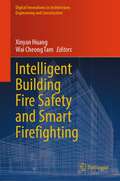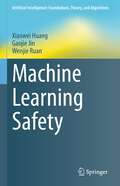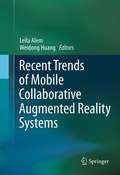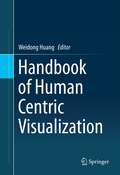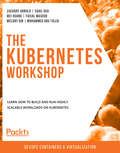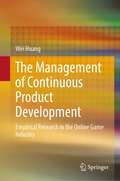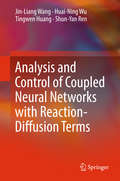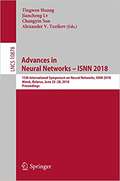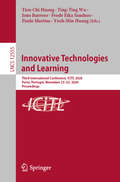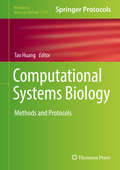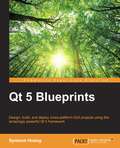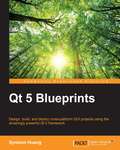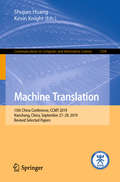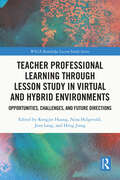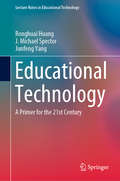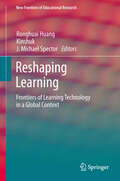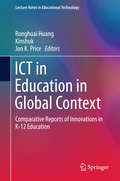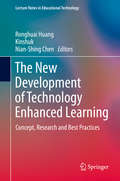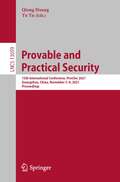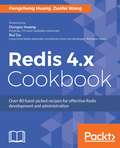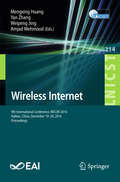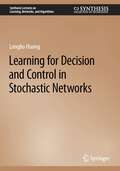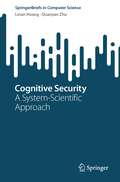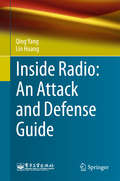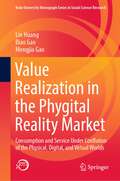- Table View
- List View
Intelligent Building Fire Safety and Smart Firefighting (Digital Innovations in Architecture, Engineering and Construction)
by Xinyan Huang Wai Cheong TamThis book provides the latest research and technology advances in building fire safety and smart firefighting. Different experts systemically review the application of new technologies like Artificial Intelligence, Internet of Things, Virtual Reality, Digitalization, and Metaverse in fire safety areas. These multi-disciplinary research and technology fusion will significantly change the fire resilience design and firefighting practices in the next 20 years. Achieving urban fire safety and resilience also plays a key role in developing future smart buildings and cities. This book attracts more young researchers into the latest multi-disciplinary fire safety research and promotes the application of the new technologies in firefighting.
Machine Learning Safety (Artificial Intelligence: Foundations, Theory, and Algorithms)
by Xiaowei Huang Gaojie Jin Wenjie RuanMachine learning algorithms allow computers to learn without being explicitly programmed. Their application is now spreading to highly sophisticated tasks across multiple domains, such as medical diagnostics or fully autonomous vehicles. While this development holds great potential, it also raises new safety concerns, as machine learning has many specificities that make its behaviour prediction and assessment very different from that for explicitly programmed software systems. This book addresses the main safety concerns with regard to machine learning, including its susceptibility to environmental noise and adversarial attacks. Such vulnerabilities have become a major roadblock to the deployment of machine learning in safety-critical applications. The book presents up-to-date techniques for adversarial attacks, which are used to assess the vulnerabilities of machine learning models; formal verification, which is used to determine if a trained machine learning model is free of vulnerabilities; and adversarial training, which is used to enhance the training process and reduce vulnerabilities. The book aims to improve readers’ awareness of the potential safety issues regarding machine learning models. In addition, it includes up-to-date techniques for dealing with these issues, equipping readers with not only technical knowledge but also hands-on practical skills.
Recent Trends of Mobile Collaborative Augmented Reality Systems
by Weidong Huang Leila AlemThe use of mobile collaborative AR has expended rapidly in recent years, due to the major advances in hardware and networking. The application areas are diverse and multidisciplinary. Recent Trends of Mobile Collaborative Augmented Reality Systems provides a historical overview of previous mobile collaborative AR systems, presents case studies of latest developments in current mobile collaborative AR systems, and latest technologies and system architectures used in this field. Recent Trends of Mobile Collaborative Augmented Reality Systems is designed for a professional audience composed of practitioners and researchers working in the field of augmented reality and human-computer interaction. Advanced-level students in computer science and electrical engineering focused on this topic will also find this book useful as a secondary text or reference.
Handbook of Human Centric Visualization
by Weidong HuangVisualizations are visual representations of non-visual data. They are produced for people to interact with and to make sense of the underlying data. Rapid advances in display technology and computer power have enabled researchers to produce visually appealing pictures. However, the effectiveness of those pictures in conveying the embedded information to end users has not been fully explored. Handbook of Human Centric Visualization addresses issues related to design, evaluation and application of visualizations. Topics include visualization theories, design principles, evaluation methods and metrics, human factors, interaction methods and case studies. This cutting-edge book includes contributions from well-established researchers worldwide, from diverse disciplines including psychology, visualization and human-computer interaction. This handbook is designed for a professional audience composed of practitioners, lecturers and researchers working in the field of computer graphics, visualization, human-computer interaction and psychology. Undergraduate and postgraduate students in science and engineering focused on this topic will also find this book useful as a comprehensive textbook or reference.
The Kubernetes Workshop: Learn how to build and run highly scalable workloads on Kubernetes
by Wei Huang Melony Qin Zachary Arnold Sahil Dua Faisal Masood Mohammed Abu TalebFrom building your own cluster to running cloud-native applications with Kubernetes, this workshop covers it all using engaging examples and activities Key Features Explore the Kubernetes environment and understand how containers are managed Learn how to build, maintain, and deploy cloud-native applications using Kubernetes Get to grips with using Kubernetes primitives to manage the life cycle of a full application stack Book Description Thanks to its extensive support for managing hundreds of containers that run cloud-native applications, Kubernetes is the most popular open source container orchestration platform that makes cluster management easy. This workshop adopts a practical approach to get you acquainted with the Kubernetes environment and its applications. Starting with an introduction to the fundamentals of Kubernetes, you'll install and set up your Kubernetes environment. You'll understand how to write YAML files and deploy your first simple web application container using Pod. You'll then assign human-friendly names to Pods, explore various Kubernetes entities and functions, and discover when to use them. As you work through the chapters, this Kubernetes book will show you how you can make full-scale use of Kubernetes by applying a variety of techniques for designing components and deploying clusters. You'll also get to grips with security policies for limiting access to certain functions inside the cluster. Toward the end of the book, you'll get a rundown of Kubernetes advanced features for building your own controller and upgrading to a Kubernetes cluster without downtime. By the end of this workshop, you'll be able to manage containers and run cloud-based applications efficiently using Kubernetes. What you will learn Get to grips with the fundamentals of Kubernetes and its terminology Share or store data in different containers running in the same pod Create a container image from an image definition manifest Construct a Kubernetes-aware continuous integration (CI) pipeline for deployments Attract traffic to your app using Kubernetes ingress Build and deploy your own admission controller Who this book is for Whether you are new to the world of web programming or are an experienced developer or software engineer looking to use Kubernetes for managing and scaling containerized applications, you'll find this workshop useful. A basic understanding of Docker and containerization is necessary to make the most of this book.
The Management of Continuous Product Development: Empirical Research in the Online Game Industry
by Wei HuangThis book discusses theoretically and empirically the trade-off relationship between the frequency of product adaptation activities and the constraints on development resources, and how companies can respond to these constraints. The objective of this book is to identify effective management practices in continuous product development. With the continuation of development activities, companies are required to constantly adapt their products to changes in the external environment. In continuous product development, the development process extends beyond product release, and interaction with the external environment is not limited to the planning stage but occurs multiple times throughout the process. What impact does the multiple adaptation activities have on the product performance as development activities become more continuous, and how to use limited development resources to provide stable and constant high-quality adaptation activities with optimal frequency have become urgent issues in the development sites. To address these research questions, this book focuses primarily on the development activities of the online game industry. The factors that bring about superior product performance are examined by combining case studies and questionnaire surveys on online game development projects. Furthermore, user community management is also discussed from the perspective of the interaction process between multiple user groups.
Analysis and Control of Coupled Neural Networks with Reaction-Diffusion Terms
by Tingwen Huang Jin-Liang Wang Huai-Ning Wu Shun-Yan RenThis book introduces selected recent findings on the analysis and control of dynamical behaviors for coupled reaction-diffusion neural networks. It presents novel research ideas and essential definitions concerning coupled reaction-diffusion neural networks, such as passivity, adaptive coupling, spatial diffusion coupling, and the relationship between synchronization and output strict passivity. Further, it gathers research results previously published in many flagship journals, presenting them in a unified form. As such, the book will be of interest to all university researchers and graduate students in Engineering and Mathematics who wish to study the dynamical behaviors of coupled reaction-diffusion neural networks.
Advances in Neural Networks – ISNN 2018: 15th International Symposium On Neural Networks, ISNN 2018, Minsk, Belarus, June 25-28, 2018, Proceedings (Theoretical Computer Science and General Issues #10878)
by Tingwen Huang Jiancheng Lv Changyin Sun Alexander V. TuzikovThis book constitutes the refereed proceedings of the 15th International Symposium on Neural Networks, ISNN 2018, held in Minsk, Belarus in June 2018.The 98 revised regular papers presented in this volume were carefully reviewed and selected from 214 submissions. The papers cover many topics of neural network-related research including intelligent control, neurodynamic analysis, bio-signal, bioinformatics and biomedical engineering, clustering, classification, forecasting, models, algorithms, cognitive computation, machine learning, and optimization.
Innovative Technologies and Learning: Third International Conference, ICITL 2020, Porto, Portugal, November 23–25, 2020, Proceedings (Lecture Notes in Computer Science #12555)
by Tien-Chi Huang Ting-Ting Wu João Barroso Frode Eika Sandnes Paulo Martins Yueh-Min HuangThis book constitutes the refereed proceedings of the Second International Conference on Innovative Technologies and Learning, ICITL 2020, held in Porto, Portugal, in November 2020. The 65 full papers presented together with 2 short papers were carefully reviewed and selected from 127 submissions. The papers are organized in the following topical sections: Augmented and Virtual Reality in Education; Educational Data Mining and Learning Analytics; Emerging Issues and Trends in Education; Innovative Learning in Education; Online Course and Web-Based Environment; Technology-Enhanced Learning; Application and Design of Innovative Learning Software; and Science, Technology, Engineering, Arts and Design, and Mathematics.Due to the Corona pandemic this event was held virtually.
Computational Systems Biology: Methods And Protocols (Methods In Molecular Biology #1754)
by Tao HuangThis volume introduces the reader to the latest experimental and bioinformatics methods for DNA sequencing, RNA sequencing, cell-free tumour DNA sequencing, single cell sequencing, single-cell proteomics and metabolomics. Chapters detail advanced analysis methods, such as Genome-Wide Association Studies (GWAS), machine learning, reconstruction and analysis of gene regulatory networks and differential coexpression network analysis, and gave a practical guide for how to choose and use the right algorithm or software to handle specific high throughput data or multi-omics data. Written in the highly successful Methods in Molecular Biology series format, chapters include introductions to their respective topics, lists of the necessary materials and reagents, step-by-step, readily reproducible laboratory protocols, and tips on troubleshooting and avoiding known pitfalls.Authoritative and cutting-edge, Computational Systems Biology: Methods and Protocols aims to ensure successful results in the further study of this vital field.
Qt 5 Blueprints
by Symeon HuangIf you are a programmer looking for a truly cross-platform GUI framework to help you save your time by side-stepping the incompatibility between different platforms and building applications using Qt 5 for multiple targets, then this book is most certainly intended for you. It is assumed that you have a basic programming experience of C++ and fundamental knowledge about Qt.
Qt 5 Blueprints
by Symeon HuangIf you are a programmer looking for a truly cross-platform GUI framework to help you save your time by side-stepping the incompatibility between different platforms and building applications using Qt 5 for multiple targets, then this book is most certainly intended for you. It is assumed that you have a basic programming experience of C++ and fundamental knowledge about Qt.
Machine Translation: 15th China Conference, CCMT 2019, Nanchang, China, September 27–29, 2019, Revised Selected Papers (Communications in Computer and Information Science #1104)
by Shujian Huang Kevin KnightThis book constitutes the refereed proceedings of the 15th China Conference on Machine Translation, CCMT 2019, held in Nanchang, China, in September 2019.The 10 full papers presented in this volume were carefully reviewed and selected from 21 submissions and focus on all aspects of machine translation, including preprocessing, neural machine translation models, hybrid model, evaluation method, and post-editing.
Teacher Professional Learning through Lesson Study in Virtual and Hybrid Environments: Opportunities, Challenges, and Future Directions (WALS-Routledge Lesson Study Series)
by Rongjin Huang Nina Helgevold Jean Lang Heng JiangOffering a rich, critical investigation of how technology can be used to strengthen and promote lesson study in both virtual and hybrid environments, this edited book presents insights into the numerous challenges as well as opportunities for supporting teachers’ and teacher educators’ professional learning in such a novel setting. Providing an international perspective, research in this book highlights on the one hand the necessity of exploring how the known theoretical perspectives and methodological approaches for researching on lesson study and effective characteristics of conducting lesson study can be adapted to the new environments. On the other hand, further analysis reveals the benefits of using various advanced technologies in lesson study, the new practice of professional development of teachers and teacher educators, and also documents related issues of conducting lesson study in such complex contexts. The chapters focus on online cross-cultural lesson study; the key aspects of conducting online lesson study and the effectiveness of it. Features of facilitation and the development of facilitators for online lesson study are explored, alongside the ways in which online lesson study can help address various problems of practice such as implementing equitable teaching, facilitating student interaction in virtual environments, and migration to remote teaching in STEM. This resourceful text provides needed support to both researchers and practitioners, from primary to higher education, with special attention to both teacher and student learning.
Educational Technology: A Primer for the 21st Century (Lecture Notes in Educational Technology)
by Ronghuai Huang J. Michael Spector Junfeng YangThe aim of this book is to prepare students with knowledge and skills to understand the organizational needs and requirements of educational technology. Students should be able to use and manage both existing and emerging technologies effectively and be able to apply associated pedagogies to suit the environment, but also evaluate and manage technological advances of future and the requisite pedagogical shifts to achieve efficiency and effectiveness. The demand of educational technology has been rising steadily, primarily due to the fact that e-learning is a huge and significantly expanding world-wide industry. Commercial e-learning companies, training departments in large companies and organizations, computer software companies and educational institutions the world over employ large numbers of educational technology specialists. There is a strong demand for technologists who understand educational theories and for instructional designers and teachers who understand technologies. This book is targeted towards those who are looking for career in educational technology, instructional design, or media and information systems, or may want to continue their studies in graduate programs in learning and instructional technology, and those who are interested in becoming teacher in K-12 setting but need background in educational technology. This book will also act as a valuable resource in teacher education programs where primary focus on mainstream education and requires an authentic resource in instructional design and educational technology. Keeping in mind the varied needs of the organizations, employees and potential students, this book adopts a competency approach to learning and assessment. The themes and topics take a multi-disciplinary approach, and are aimed at preparing students for competent and innovative educational technology professionals.
Reshaping Learning
by Ronghuai Huang J. Michael Spector KinshukThis edited volume with selected papers from extinguished experts and professors in the field of learning technology and the related fields who are far-sighted and have his/her own innovative thoughts on the development of learning technology. This book will addresses the main issues concerned with the trend and future development of learning processes, innovative pedagogies changes, effects of new technologies on education, future learning content. Learning technology has been affected by advances in technology development and changes in the field of education. Nowadays we cannot afford to sense the changes and then make adaption to it. What we should do is to predict the changes and make positive and active reactions to help the trend go smoothly and in a more beneficial way. This book aims to gather the newest ideas on the frontiers and future development of learning education from the aspects of learning, pedagogies, and technologies in learning in order to draw a picture of learning education in the near future.
ICT in Education in Global Context
by Ronghuai Huang Kinshuk Jon K. PriceThis book aims to capture the current innovation and emerging trends of digital technologies for learning and education in k-12 sector through a number of invited chapters in key research areas. Emerging Patterns of innovative instruction in different context, Learning design for digital natives, Digital learning resources for personalized learning in both formal and informal educational settings, e-leadership and teacher's digital capacity will be covered in the book. This book intends to provide reference for the innovation in K-12 schools. Researchers, policy makers, school administrators and also teachers could benefit from this book on researchers and methods for innovation in K-12 schools all over the world.
The New Development of Technology Enhanced Learning
by Ronghuai Huang Kinshuk Nian-Shing ChenThe book addresses the main issues concerned with the new development of learning processes, innovative pedagogical changes, the effects of new technologies on education, future learning content, which aims to gather the newest concepts, research and best practices on the frontiers of technology enhanced learning from the aspects of learning, pedagogies and technologies in learning in order to draw a picture of technology enhanced learning in the near future. Some issues like "e-learning . . . m-learning . . . u-learning - innovative approaches," "the Framework and Method for Understanding the New Generation Students," "Context-aware Mobile Role Playing Game for Learning," " Pedagogical issues in content creation and use: IT literacy through Spoken Tutorials," "Supporting collaborative knowledge construction and discourse in the classroom," "Digital Systems for Hierarchical Open Access to Education," " Using Annotated Patient Records to Teach Clinical Reasoning to Undergraduate Students of Medicine," " Utilizing Cognitive Skills Ontology for Designing Personalized Learning Environments" and "Using Interactive Mobile Technologies to Develop Operating Room Technologies Competency" are discussed in separate chapters.
Provable and Practical Security: 15th International Conference, ProvSec 2021, Guangzhou, China, November 5–8, 2021, Proceedings (Lecture Notes in Computer Science #13059)
by Qiong Huang Yu YuThis book constitutes the refereed proceedings of the 15th International Conference on Provable Security, ProvSec 2021, held in Guangzhou, China, in November 2021. The 21 full papers presented were carefully reviewed and selected from 67 submissions. The papers focus on provable security as an essential tool for analyzing security of modern cryptographic primitives. They are divided in the following topical sections: Searchable Encryption, Key Exchange & Zero Knowledge Proof, Post Quantum Cryptography, Functional Encryption, Digital Signature, and Practical Security Protocols.
Redis 4.x Cookbook: Over 80 hand-picked recipes for effective Redis development and administration
by Pengcheng Huang Zuofei WangLeverage the power of Redis 4.x to develop, optimize and administer your Redis solutions with ease Key Features Build, deploy and administer high performance and scalable applications in Redis Covers a range of important tasks - including development and administration of Redis A practical guide that takes your understanding of Redis to the next level Book Description Redis is considered the world's most popular key-value store database. Its versatility and the wide variety of use cases it enables have made it a popular choice of database for many enterprises. Based on the latest version of Redis, this book provides both step-by-step recipes and relevant the background information required to utilize its features to the fullest. It covers everything from a basic understanding of Redis data types to advanced aspects of Redis high availability, clustering, administration, and troubleshooting. This book will be your great companion to master all aspects of Redis. The book starts off by installing and configuring Redis for you to get started with ease. Moving on, all the data types and features of Redis are introduced in detail. Next, you will learn how to develop applications with Redis in Java, Python, and the Spring Boot web framework. You will also learn replication tasks, which will help you to troubleshoot replication issues. Furthermore, you will learn the steps that need to be undertaken to ensure high availability on your cluster and during production deployment. Toward the end of the book, you will learn the topmost tasks that will help you to troubleshoot your ecosystem efficiently, along with extending Redis by using different modules. What you will learn Install and configure your Redis instance Explore various data types and commands in Redis Build client-side applications as well as a Big Data framework with Redis Manage data replication and persistence in Redis Implement high availability and data sharding in Redis Extend Redis with Redis Module Benchmark, debug, fine-tune and troubleshoot various issues in RedisWho this book is for This book is for database administrators, developers and architects who want to tackle the common and not so common problems associated with the different development and administration-related tasks in Redis. A fundamental understanding of Redis is expected to get the best out of this book.
Wireless Internet
by Mengxing Huang Yan Zhang Weipeng Jing Amjad MehmoodUbiquitous and pervasive technologies such as RFID and smart computing promise a world of networked and interconnected devices. Everything from tires to toothbrushes could soon be in communications range, heralding the dawn of an era in which today's Internet of Peoplegives way to tomorrow's Internet of Things-- where billions of objects will have the ability to report their location, identity, and history over wireless connections. Connectivity and Communication -- Anything, Anywhere, and Anytime An examination of the exciting expansion period in this research, TheInternet of Things: From RFID to the Next-Generation Pervasive Networked Systemsprovides comprehensive, technical, and practical deploying policy guidance that covers fundamentals and recent advances in pervasive networked systems. The book addresses the conceptual and technical issues that influence the technology roadmap and gives an in-depth introduction to the Internet of Thingsand its effect on businesses and individuals. Discussing case studies, experience reports, and best practice, it contains information on emerging technologies, market opportunities, and policy implications. Practical Guidance and Balanced Coverage The first book of its kind to address major new technological developments and define the Internet of Things, this text provides balanced coverage of theory and practical issues. Reflecting research trends and industry needs, itis a comprehensive technical and practical guide to recent advances in pervasive networked systems.
Learning for Decision and Control in Stochastic Networks (Synthesis Lectures on Learning, Networks, and Algorithms)
by Longbo HuangThis book introduces the Learning-Augmented Network Optimization (LANO) paradigm, which interconnects network optimization with the emerging AI theory and algorithms and has been receiving a growing attention in network research. The authors present the topic based on a general stochastic network optimization model, and review several important theoretical tools that are widely adopted in network research, including convex optimization, the drift method, and mean-field analysis. The book then covers several popular learning-based methods, i.e., learning-augmented drift, multi-armed bandit and reinforcement learning, along with applications in networks where the techniques have been successfully applied. The authors also provide a discussion on potential future directions and challenges.
Cognitive Security: A System-Scientific Approach (SpringerBriefs in Computer Science)
by Linan Huang Quanyan ZhuThis book presents the latest research in cognitive security, a rapidly emerging field that addresses the vulnerabilities in human behavior and cognition that can lead to Cyber-Physical Systems (CPS) compromise. This book demonstrates that as adversaries increasingly use manipulative and deceptive information to disrupt human cognitive processes, including sensation, attention, memory, and mental operations, humans are misled into fallacious reasoning and manipulated decisions that can lead to system-level meltdown. Cognitive security aims to protect humans from the exploitation of cognitive vulnerabilities, help them make informed decisions that are free from manipulation and undue influence, and mitigate the aggravating risk in the ensuing steps of the attacker’s kill chain. This book offers solutions that work across different fields, such as psychology, neuroscience, data science, social science, and game theory, to deal with cognitive threats. It guides the reader through the core ideas with figures, real-life examples, and case studies. Moreover, it formally defines all research questions, presents the results using mathematical theorems and proofs, and obtains insights through numerical validation. This book provides a self-contained and brief overview of essential system-scientific tools for modeling, analyzing, and mitigating cognitive vulnerabilities. The concepts of human cognitive capacities and cognitive vulnerabilities are formally discussed, followed by two case studies in the scenarios of reactive and proactive attention vulnerabilities. This book provides insights and applications on this transdisciplinary topic, with the goal of motivating future research in this emerging area and pushing the frontier of human-technology convergence. This book is a valuable reference for researchers and advanced-level students studying or working in cognitive security and related fields. It is also useful for decision-makers, managers, and professionals working within these related fields.
Inside Radio: An Attack and Defense Guide
by Lin Huang Qing YangThis book discusses the security issues in a wide range of wireless devices and systems, such as RFID, Bluetooth, ZigBee, GSM, LTE, and GPS. It collects the findings of recent research by the UnicornTeam at 360 Technology, and reviews the state-of-the-art literature on wireless security. The book also offers detailed case studies and theoretical treatments – specifically it lists numerous laboratory procedures, results, plots, commands and screenshots from real-world experiments. It is a valuable reference guide for practitioners and researchers who want to learn more about the advanced research findings and use the off-the-shelf tools to explore the wireless world.
Value Realization in the Phygital Reality Market: Consumption and Service Under Conflation of the Physical, Digital, and Virtual Worlds (Kobe University Monograph Series in Social Science Research)
by Lin Huang Biao Gao Mengjia GaoThis book is a timely and much-needed comprehensive compilation that reflects the development of research on consumption and communication in the conflation of the real and digital worlds, bringing together the current state of thinking about the phygital reality market and the cutting-edge challenges that are involved. In this book, the term “phygital reality market” is used, implying that the physical, digital, and virtual realms are fused into one to recognize and understand the market with multiple or mixed realities. The concept of the phygital reality market captures the new realities that consumers are shopping, consuming, and living, and companies are competing within the physical, digital, and virtual marketplaces. The book covers the research on consumption, service, and communication in the phygital reality market and compiles the current state of thinking, challenges, and cases having to do with the acceptance and diffusion of new technologies of phygital reality. The interest in the phygital reality market, such as omnichannel retailing integrating physical stores and online services, has grown hugely over the last two decades, particularly since the coronavirus pandemic. COVID triggered severe social and economic disruption around the world but has accelerated the acceptance and diffusion of new technologies in the phygital reality market, where the physical, digital, and virtual worlds are conflated. Versatile problem solving and new challenges are reflected in the value realization process of innovation — in other words, widespread acceptance and diffusion of devices or services that embody new technologies. The excitement and hype associated with the metaverse have highlighted the need to understand the creation and adoption of new technologies in consumption and marketing, recognition of the foundational role of new technologies in driving consumer behavior, and marketing theory and practice in value realization as a vital part of the process of digital transformation.
